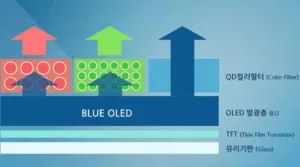Nanosys, the manufacturer or licensor of essentially all of the quantum dots in commercial usetoday, has long had a roadmap of quantum dot display architectures, each of which require particular developments in quantum dot technology and/or processing.

The architecture used in all quantum-dot (QD) or QLED TVs today is quantum-dot enhancement film (QDEF)(Fig. 1). With the QDEF architecture, quantum dots for blue-to-green and and blue-to-red conversion are dispersed between two polymer films that are laminated together to protect the dots against oxygen and moisture. The laminated film replaces the diffuser film in the backlight unit.
The next architecture in the roadmap is quantum dot on glass (QDOG) (Will QDOG Have its Day?). The architecture seems best suited for edge lights using a light guide plate (LGP), although Nanosys says it is also compatible with full area local dimming (FALD) backlights. Here, the conventional acrylic LGP is replaced with Corning Iris Glass or equivalent, and the mixture of blue-to-green and blue-to-red is sprayed or otherwise deposited onto the glass LGP. This requires QDs that are passivated against oxygen and moisture for deposition, although a passivating film is required after deposition. There have been a few low-volume QDOG TVs and monitors demonstrated, but at CES 2019 it was revealed that TCL would introduce a 19-inch QDOG monitor this March at an MSRP of $400.
The advantages of QDOG, says Nanosys, are ultra-thin design with TV panel thickness of less than 5mm, wide color gamut of more than 100% of DCI-P3, and elimination of the (second) plastic barrier film.
Fig. 1. The quantum dot on glass (QDOG) architecture replaces a plastic light guide plate (LGP) and separate quantum dot enhancement film (QDEF) with a high-stability glass on which the quantum dots are applied directly. (Graphics: Nanosys)
The next stop on the roadmap is to use a pattern of blue-to-green and blue-to-red quantum dots to replace the matrix color filter (MCF) in an LCD display. This would create an LCD display with pixels that emit close to the surface giving, arguably, an OLED-like look, and would also eliminate the expensive MCF.
Surprisingly, this concept may first appear in an OLED display architecture being developed by Samsung (Fig. 2). Here, instead of using a blue LED light source in an LCD, Samsung intends to use an unpatterned layer of blue OLED with QDs performing blue-to-red and blue-to-green color conversion. Problems with incomplete conversion, which allows blue light to leak through the red and green pixels, is leading Samsung to use an MCF after all. This problem could also affect the MCF-replacement architecture for LCDs. There are reports that Samsung could have a QD-OLED TV on the market in a very short 18 months.
Fig. 2. Samsung’s QD-OLED concept uses an unpatterned blue OLED emission later and patterned quantum dots to create red, green, and blue sub-pixels. A commercial panel could appear in 18 months. (Graphic: Unknown)
The holy grail on the Nanosys roadmap has been the electroluminescent quantum-dot (ELQD) display, which is an OLED-like structure with QD emitters replacing the OLED emission layers. The ELQD display would have all of the advantages of OLED, but without OLED’s aging and burn-in problems, and with much-needed greater luminance.
Analysts have believed that a commercial ELQD display was at least two years away, but at CES, Nanosys CEO Jason Hartlove told Display Daily that a Nanosys partner will introduce a 19-inch ELQD monitor at the end of this year.
The horizon is not only coming closer; we are about to trip over it. – Ken Werner
Ken Werner is Principal of Nutmeg Consultants, specializing in the display industry, manufacturing, technology, and applications, including mobile devices, automotive, and television. He consults for attorneys, investment analysts, and companies re-positioning themselves within the display industry or using displays in their products. He is the 2017 recipient of the Society for Information Display’s Lewis and Beatrice Winner Award. You can reach him at [email protected].

